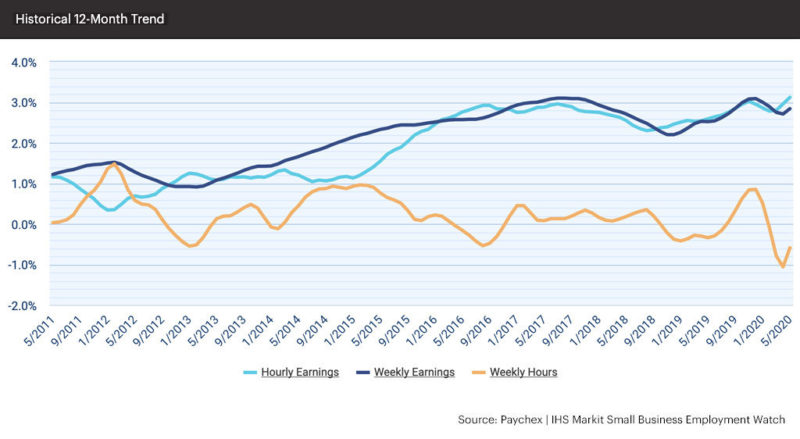

The latest Paychex | IHS Markit Small Business Employment Watch shows that employment growth improved slightly in May, up 0.25 percent, as stay-at-home orders eased in most states. Amid the economic impacts of the COVID-19 pandemic, the jobs index has fallen 3.95 percent year-over-year, most of which (3.52 percent) occurred in the past quarter. The transition back to work also resulted in a 5.33 percent one-month annualized increase in weekly hours worked after a sharp drop in April.
“May’s results hint that the small business job market quickly hit its bottom with the extraordinary job loss in April,” said James Diffley, chief regional economist at IHS Markit.
“While there are still many unknowns with the pace of recovery, the slight increase in employment numbers last month indicates that employers are starting to bring back employees who were furloughed or temporarily laid off during pandemic-related business closures,” said Martin Mucci, Paychex president and CEO. “Funds received from the Paycheck Protection Program have been helpful in supporting some businesses to retain employees and an extension of the SBA’s loan forgiveness timeline and different parameters would be a positive next step in flexibility to support business survival and recovery.”
Methodology Note: Payroll data used to calculate the Small Business Jobs Index includes employers that have temporarily suspended operations but have kept employees active (yet unpaid) on their payroll records. If the national index was reflective of only workers currently being paid, it would result in a lower jobs index level for the month of May.
The report also includes regional, state, metro, and industry level analysis, showing:
- All regions in the U.S. experienced improvement in May. However, the increase in the Northeast was marginal, up 0.01 percent.
- With Florida’s stay-at-home order lifted on May 4, the state’s jobs index is more than one point higher than any other state.
- Of the 20 metros analyzed, 14 showed improvement in May, only six slowed further.
- Up 1.22 percent to 97.73, Construction reported significant recovery in May and becomes the new top-ranked industry index.
The complete results for May, including interactive charts detailing all data at a national, regional, state, metro, and industry level, are available at www.paychex.com/employment-watch. Highlights are available below.
National Jobs Index
- As a result of the COVID-19 pandemic, the level of small business employment growth in May remained slightly below the weakest level reached during the Great Recession.
- With some small businesses beginning to reactivate workers, the national index increased slightly in May (0.25 percent).
National Wage Report
- After a significant decrease in weekly hours worked last month, the one-month annualized growth rate (based on the growth from April to May) increased to 5.33 percent.
- Due to the impact of COVID-19, the employee mix has shifted toward jobs with higher rates of pay, translating to hourly earnings growth increasing to 3.12 percent.
Regional Jobs Index
- All regions experienced improvement in May. However, the increase in the Northeast was marginal, up 0.01 percent.
- Gaining 0.40 percent from the previous month, the small business jobs index in the South increased to above 96.
- The West had the strongest gains in May, up 0.41 percent, yet its year-over-year change remains the weakest (-4.57 percent).
Regional Wage Report
- After reporting double-digit drops in one-month annualized weekly hours worked growth in March and April, the South regained some traction, increasing six percent.
- Weekly earnings growth slowed for the sixth consecutive month in the West as weekly hours worked have yet to recover.
- Hourly earnings growth increased to 3.89 percent in the Northeast, overtaking the West as the top-ranked region.
State Jobs Index
- With Florida’s stay-at-home order lifted on May 4, the state’s jobs index increased 0.90 percent reaching 97.48, more than one point higher than any other state.
- Other than Florida, all state indexes are below 97 and down more than two percent year-over-year.
- New York, the state considered the epicenter of COVID-19 in the U.S., saw its jobs index fall further in May to 92.17.
Note: Analysis is provided for the 20 largest states based on U.S. population.
State Wage Report
- At 4.75 percent, hourly earnings growth in New Jersey increased for the fourth consecutive month, topping the state rankings.
- With a decreased and different population of paid employees compared to several months ago, Massachusetts spiked in weekly earnings and hours worked.
- Texas is still decelerating as the state ranks last in all three wage components.
Note: Analysis is provided for the 20 largest states based on U.S. population.
Metropolitan Jobs Index
- Of the 20 metros analyzed, 14 showed improvement in May, only six slowed further.
- Tampa recovered 0.99 percent in May, improving to 97.42 and overtaking Denver as the top-ranked metro index.
Note: Analysis is provided for the 20 largest metro areas based on U.S. population.
Metropolitan Wage Report
- Reporting the largest drop-off in weekly hours worked growth last month, the New York metro rebounded with the highest one-month annualized growth rate in May, 18.40 percent, as employees are working more hours in May compared to April.
- Reporting 5.00 percent year-over-year hourly earnings growth, Philadelphia climbed to the top of the state rankings.
- Houston and Dallas are both showing negative weekly earnings growth and hourly earnings growth below two percent.
Note: Analysis is provided for the 20 largest metro areas based on U.S. population.
Industry Jobs Index
- Six of the eight industries analyzed showed improvement in May.
- The Leisure and Hospitality industry experienced additional decline in May, decreasing to 90.15. Its index is a full three points lower than the next weakest index, Manufacturing at 93.15.
- Up 1.22 percent to 97.73, Construction reported significant recovery in May and becomes the new top-ranked industry index.
Note: Analysis is provided for seven major industry sectors. Definitions of each industry sector can be found here. The Other Services (excluding Public Administration) industry category includes religious, civic, and social organizations, as well as personal services, including automotive and household repair, salons, drycleaners, and other businesses.
Industry Wage Report
- Weekly hours worked growth is down 4.51 percent from last year in Leisure and Hospitality, weakest among sectors.
- Financial Activities is the only sector to report positive weekly hours worked from a year ago.
Note: Analysis is provided for seven major industry sectors. Definitions of each industry sector can be found here. The Other Services (excluding Public Administration) industry category includes religious, civic, and social organizations, as well as personal services, including automotive and household repair, salons, drycleaners, and other businesses.
For more information about the Paychex | IHS Markit Small Business Employment Watch, visit www.paychex.com/employment-watch and sign up to receive monthly Employment Watch alerts.
*Information regarding the professions included in the industry data can be found at the Bureau of Labor Statistics website.
About the Paychex | IHS Markit Small Business Employment Watch
The Paychex | IHS Markit Small Business Employment Watch is released each month by Paychex, Inc., a leading provider of payroll, human resource, insurance, and benefits outsourcing solutions for small-to medium-sized businesses, and IHS Markit, a world leader in critical information, analytics, and expertise. Focused exclusively on small business, the monthly report offers analysis of national employment and wage trends, as well as examines regional, state, metro, and industry sector activity. Drawing from the payroll data of approximately 350,000 Paychex clients, this powerful tool delivers real-time insights into the small business trends driving the U.S. economy.




